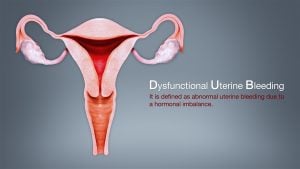Table of Contents
What is dysfunctional uterine bleeding?

Dysfunctional uterine bleeding or vaginal bleeding is heavy or unusual bleeding from the uterus through the vagina. It can occur during a monthly cycle or normal menstrual period. Dysfunctional uterine bleeding is the most common symptom of endometrial, cervix and uterine cancer .
How bad is my uterine bleeding?
Mild: You may have heavy menstrual bleeding, unusual bleeding (between periods, after sex, during menopause), unusual long periods (seven days or longer) and inconsistent menstrual cycles.
Moderate: You may experience bloating, pelvic pain, and pelvic pressure in addition to the above symptoms. Medical treatment can manage moderate vaginal bleeding.
Severe: You may experience passing large clots, low blood pressure, weakness, fainting, and dizziness. It is an emergency that requires immediate treatment under your doctor’s supervision.
How to manage dysfunctional uterine bleeding?
Keep track of your symptoms using Ankr (myAnkr web portal or the Ankr app). It will help you describe the discomfort to your doctor or nurse.
You may not be able to prevent bleeding between periods depending on the cause. However, in some cases, preventive measures can help.
- Maintain a healthy lifestyle and a normal weight because being overweight can lead to abnormal periods.
- If you take birth control pills, do so as directed to avoid a hormonal imbalance.
- Iron supplements can manage mild vaginal bleeding.
- Exercise moderately to maintain health and reduce stress.
How to manage severe dysfunctional uterine bleeding?
Contact your doctor in the following situations:
- Postmenopausal women not taking hormone therapy should see a doctor if they experience vaginal bleeding.
- Postmenopausal women taking cyclic hormone therapy may experience some vaginal bleeding. A cyclic hormone therapy regimen — oral estrogen daily plus oral progestin for 10 to 12 days a month — can lead to bleeding that resembles a period (withdrawal bleeding) for a few days out of the month. If you have bleeding other than expected withdrawal bleeding, contact your doctor.
- Postmenopausal women taking continuous hormone therapy — a low-dose combination of estrogen and progestin daily — may experience light, irregular bleeding for the first six months. If bleeding persists longer or heavy bleeding begins, see your doctor.
- Girls who don’t have any other signs of puberty or are younger than age 8 should have any vaginal bleeding investigated.
What causes dysfunctional uterine bleeding?
A variety of things can cause abnormal uterine bleeding. Pregnancy is a common cause. Polyps or fibroids (small and large growths) in the uterus can also cause bleeding. Rarely, a thyroid problem, infection of the cervix, or uterine cancer can cause abnormal uterine bleeding.
In most women, a hormone imbalance causes abnormal uterine bleeding. When hormones are the problem, doctors call the problem dysfunctional uterine bleeding or DUB. Abnormal bleeding caused by hormone imbalance is more common in teenagers or in women who are approaching menopause.
